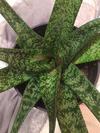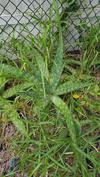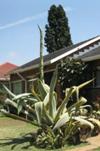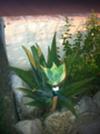Aloe Plants
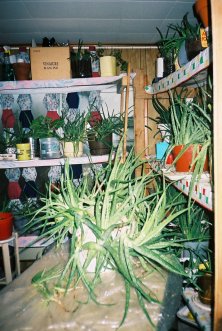
There are 300 or more species of aloe plants - cousins to my aloe vera, and many hybrids too. Our humble aloe vera house plants are also found naturally in very dry, hot areas, and seen widely in Asia and Africa especially.
Visitors to my site, often ask to have their aloe plants identified. I'm afraid I'm not the best person for that, as I've only seen the aloe vera kind, but I do provide a way to submit photos so that perhaps someone else coming by may know and comment to indicate what kind of plant it is.
I am curious though, as to how some of these aloe cousins look, and since it is against my ethical standards to snitch photos from other sites, I would be so tickled, if you have photos of these other aloe plants, - if you would offer them to be posted here to illustrate this page. (See near the bottom for how).
Some friends have complained to me that they can't get aloes to grow or thrive in their home; while I could hardly hold them back! My aloe vera plants (back at Dad's house) thrived even in the sunroom, which got cold enough in our Canadian winters to use as a cold storage or fridge room. They did not like the hot humid summer days though.
Don't believe it if you read that all aloe plants are toxic. If there are some sub-species that are toxic, they would be the exception. My Dad (who reached age 91) and I ate the gel in the aloe leaves with great healing results. The green outer skin of the aloe vera leaves is bitter, but edible. I knew one woman in our community who insists on eating the bitter green skin too.
While many have heard that it is a good plant to apply to a wound or burn, I tell you it can do much more. Check out the rest of this site to learn about aloe vera plants and their uses.
I have discovered on the internet there are many varieties of aloe plants. As I said at the top, some say 200, some 300, and some even insist there are 500 varieties. I won't attempt to verify those numbers, but I thought I'd mention some of the aloe cousins for our curiosity's sake.
The Aloe bainesii, for example, is a TREE!! Can you imagine aloe vera growing on trees? All aloe plants seem to have these general characteristics; they are succulents from the lily family, and have healing properties. Aloe plants thrive in dry hot desert areas, and are drought tolerant, needing little care, and they have showy flowers.
It would be interesting to confirm if all these other aloes plants (the cousins) have healing properties too!
See the invitation below to help add photos and more details to these cousins.
Aloe bainesii (or Aloe barberae)
This one grows anywhere from 30 ft to 55 ft tall. It has a stout base trunk with many forked branches. It's blossoms are green with rose-coloured
tips which are approximately an inch across.
The two names, Aloe barberae, and Aloe bainesii, was published simultaneously for the same aloe plant. In a scientific paper that was overlooked, the name A. barberae was chosen, it is for this reason that the name was reinstated. Aloe barberae was named after Mary Elizabeth Barber (nee Bowker) who was one of the pioneer plant collectors of South Africa.
Aloe aristata, Torch Plant, Lace Aloe
This dwarf species has no stem, but grows in dense rosettes of four inch leaves, with raised soft white pointed teeth along the edges. It is ideal
to grow in rock gardens and edgings or in pots. It flowers in early summer with a two foot stock. It produces orange-red blooms in early summer,
which must be why this aloe is called the torch plant. The white picoed edges would cause others to call it the lace aloe plant.
Aloe Distans, Jewelled Aloe
Here's a low-growing aloe plant, that sends its succulent stems along the ground and turns its ends up. The leaves form the signature whirl or
rosette of leaves in blue-green, with tiny spines on their edges. It blooms in early summer with flowers that range from dull scarlet, to
yellow with some orange.
Aloe Dichotoma
Again, a succulent plant, which grows to about 20 to 27 feet tall, and about 20 feet wide. It blooms in early summer and on through late summer.
Say! That's much bigger than my own aloe vera! The flowers are yellow, and it likes full or partial sun.
Aloe Dorotheae
The size of this aloe plant compares more to mine at 2 -3 foot heights, with about 3 foot widths, but this one has red and yellow flowers with
green tips from early winter and on through. It is nearly stemless, with succulent leaves that start out green but become brownish-red with long
spots as it matures. It likes full and partial sun.
Aloe Ferox
Here's another large sized aloe tree. It grows to a height of 6 to 10 feet, and is 6 feet wide. It bears orange flowers from mid- to late spring.
It loves lots of full sun. The flowers look something like what I've seen on my own aloe vera, just much larger and more vivid. Apparently
it thrives in dry, hot climates, and is suitable for container planting, and is easy to maintain. Just a note, it is susceptible to root rot.
Aloe Glauca
This shorter aloe tree has clusters of tubular pale pink or salmon flowers in spring, and it does well in places where they have hot summers and
rainy winters like they have in South Africa where it is native. It can grow to over 4 feet tall, and spread out to a width of 4 feet too.
Aloe Humilis Echinata, Spider Aloe, Crocodile Jaws
I can't tell you why it has so many names, but it looks more like my aloe vera plants, except for the bluish tinge, and all those extra white teeth
along the sides. It has bloom spikes with stunningly scarlet or orange blossoms. What a contrast! They say it grows only 4-8 inches high, but it
spreads out about a foot and a half. (I wonder if the inches is a typo).
Aloe Nobilis, Gold Tooth Aloe
Here's one to grow in a pot or as an edging in your garden. It takes up very limited root space. It grows very thick leaves with lots of horny teeth
along the sides. It fits into containers well. This aloe plant blooms from late spring to mid-summer with brillant orange and red flowers.
Don't hesitate to keep this one in the sun.
Aloe Plicatilis
This looks like flattened bananas to me, but I read that it grows from 3 to 8 feet high, and about 4 feet across. The leaves are more like fans
than rosettes in this aloe plant. It blooms with red flowers from mid-spring to mid-summer and those flowers attract the hummingbirds.
Aloe x Principis
Apparently this aloe-plant grows large clumps of rosettes, reaching 4-6 feet high, and bearing red flowers too, but the dead leaves tend to droop
like a cloak around the live ones. It likes full, hot sun.
Aloe Ramosissima
This aloe looks interesting. Its gel-filled leaves grow in a twirling rosette layer after layer, getting taller and taller. It can reach tree size,
but will stay smaller if grown in a container or pot. It has winter-blooming yellow flowers, and sometimes they get a greenish tinge.
Aloe Speciosa
You ought to go to see these aloe-plants! It looks like a bunch of
cucumbers sticking up right side by side, with dark and light green stripes up them. Out of the ends pointing up come red little sword-like blooms.
They say the leaves have dark pink to red margins and red teeth. I couldn't see that, but won't argue. It can grow to a height of 12 to 18 feet,
and I'd love to see that. It must be quite the sight!
Aloe Striata, Coral Aloe
An aloe plant that loves a hot dry country. In the heat the blue-green leaves go reddish-pink on the edges. It needs some protection from the
heat of the sun, but it bears brilliant coral-pink to orange flowers in the spring. This aloe plant can be grown as a houseplant... hint, hint.
(Since I don't steal pictures from other sites, it may be a while before I am able to get photos to illustrate these descriptions. I will be happy to publish them here if anyone would offer one). Here's a site with quite a few! a tripod site with 159 by my count. (Wonder how they found that many?) Click on the small photos to see the larger version.
Got a Photo of an Aloe Plant near You?
Got some unusual Aloe Cousins near you? Would you send a photo and a description? Try to include the name if you know it.
What Other Visitors Have Said
Click below to see contributions from other visitors to this page...
Help identify my aloe 




I need help identifying this aloe ... someone have it to me 3 yrs ago .. it was a scrawny sickly little plant ... it has been thriving my my storefront …
Unidentifid Aloe 




Do you know what type this is? Can't find it anywhere.
No Picture, but My Aloe Plants Never Bloom 




Hello,
My aloe plants do multiply to where they start coming out of the pot, but they have never bloomed nor do they get real big, the only get about …
Please Help Confirm My Aloe Plant 




I have no idea what kind of aloe I have, I'm in Florida. I'd love to know if this is safe to eat or apply topically. Thank you so much for your consideration. …
Is this an aloe plant? 




This was taken on the grounds of a museum in Lima, Peru, and I'm,not exactly sure what to identify it as.
If you could help that would be great!
…
Mr. A.G.Almond's Plant - Is it an Aloes? 




Been trying to find the correct name for this aloe. We know it has been here in our garden for 35 years at least, and now for the first time, it has sent …
What Type Aloe 




This Aloe has red flowers that rise about 3 feet at most. flower stalk splits into 3 branches, each with one or more smaller branches that contain the …
I hope you can tell me if this is edible 




I have had this plant for quite some time it put flowers on this past spring for the first time a long stem came up from the middle with a cluster of …
My ALoe Vera Plant 




I know nothing about this plant. My mother tells me it comes from the Botanical Gardens in Montreal and that it's a very rare species. I don't know.
…
Marie's Unusual Plant - Is it an Aloes? Not rated yet
It looks like an aloe, but not sure what species.
Thanks, Marie, for sharing this photo.
I do not recognize it myself, but I know that there are many …
My sister's aloe (?) plant with flower spike. Not rated yet
My sister lives near Austin, TX. and she walked out to find this spike growing from the center of her aloe plant this morning! She took pics with her …
My two Aloe plants. Not rated yet
I bought 2 aloe plants at a store. They were both very small at the start. I got them 2 years ago, somewhere in 2010. They have grown quite a lot in those …
Vero's Aloe Vera plant with another growing on stalk Not rated yet
We have really good luck growing these plants. We have many around the house in Corona, California.
This one plant grew a stalk which we thought would …
Please note: When you enter a question here a new page will be created, but it is rather awkward if you only put down a few words, I would encourage you to write out a full paragraph or two at least so that others who come along have as many facts as possible to help identify your aloe plant. - Or, because I try to answer such 'to-short' questions, I need your email in the form to reach you.
Get all your Forever Living (Aloe) Products HERE!
Join Forever as a Preferred Customer or a Distributor, and get 15-30% off your own purchases!

